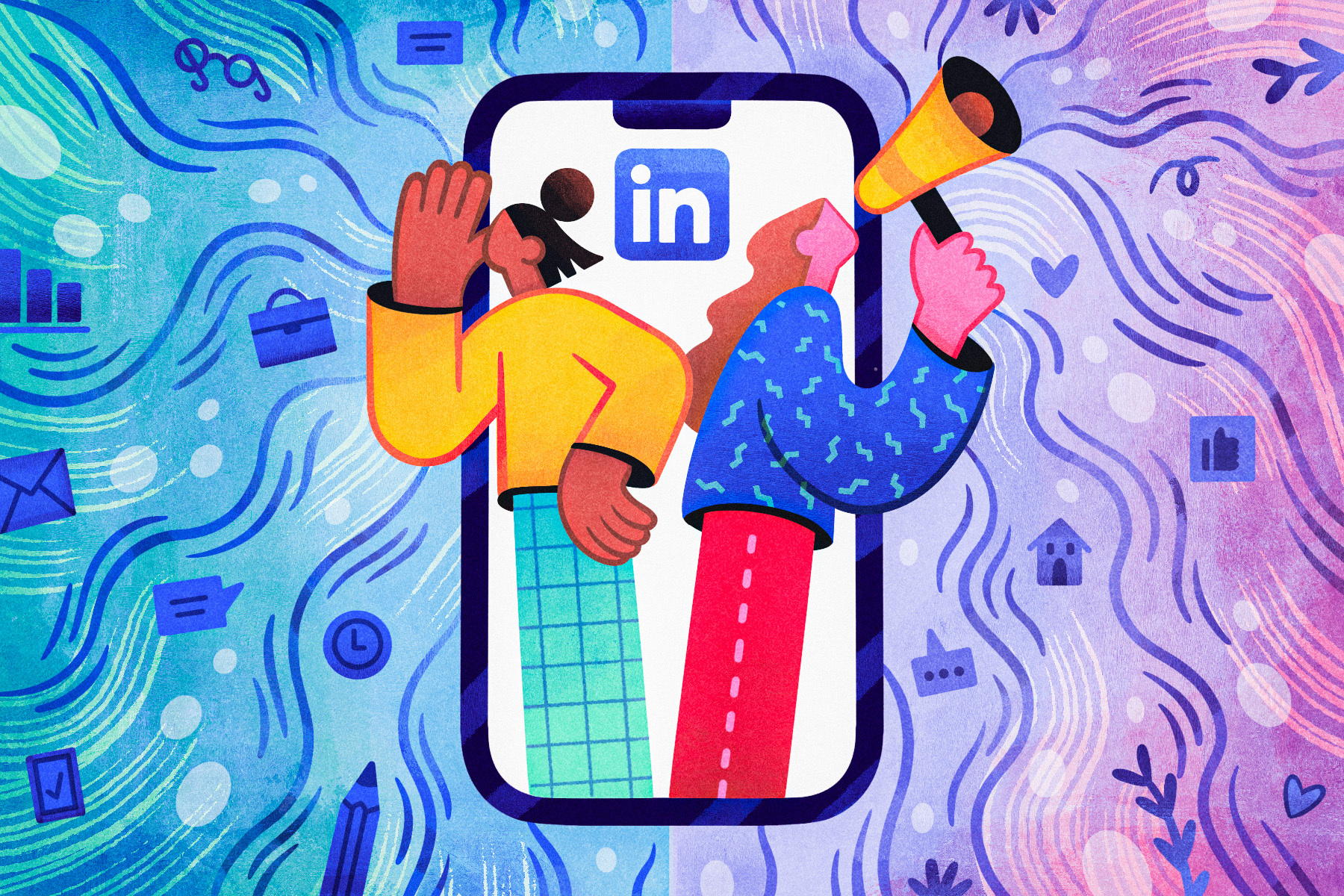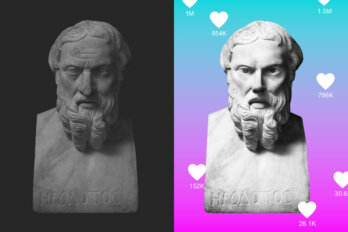The morning after the Oscars, Twitter was aflutter with takes on The Slap: Will Smith striking Chris Rock for a misguided joke in which Rock compared Jada Pinkett Smith’s shorn hair to GI Jane (Pinkett Smith, Smith’s wife, has alopecia). While writers, comedians, and the aspiringly viral duked it out for worst opinion, one wry aphorism cut through the chatter: “LinkedIn today is gonna be like ‘here’s what the Will Smith slap can teach us about thought leadership,’” tweeted Sam Rudykoff, a Toronto-based copywriter. The tweet worked because it came true; LinkedIn feeds everywhere were flooded with missives about what professional-development opportunities could be derived from Smith’s behaviour. Some preached the importance of anger management on the job. Others made the remarkable leap of linking the incident back to conflict resolution in real estate disputes.
To any of LinkedIn’s 830 million users, Rudykoff’s tweet captures how the rush to chime in on trending topics and the pressure to always be posting content, specifically personal thoughts and opinions, has transformed the networking site into a professional confessional. After Microsoft acquired LinkedIn, in 2016, the site underwent a redesign such that it now resembles Facebook, with newsfeeds, direct messaging, and trending topics. In 2019, the company introduced livestreaming. It also flirted with ephemeral content, introducing Stories in fall 2020. The feature was similar to Facebook, Instagram, and Snapchat tools where posted videos disappear after a set time, though that was phased out roughly a year later. And, in March 2021, LinkedIn launched creator mode, a suite of features to help ordinary users publish more content and grow their follower base. These changes helped transform the site from a staid social-networking platform for white-collar workers and the recruiters who court them into more of a content platform, where personal milestones, cultural events, and current affairs are refracted through the lens of professional development.
Today, posts announcing new jobs, promotions, and layoffs are often diaristic, meandering and bursting with gratitude for the bonds formed and wisdom gained in workplaces past. There are birth announcements, obituaries, and missives on everything from the challenges of parenthood to the wonders of acquiring a new hobby—often shoehorned into a teachable lesson about work. They are frequently packed with all the earnestness, emotional heft, and epiphanies of self-discovery of an ayahuasca trip. Some, like Eileen Dooley, a talent and leadership development specialist and leadership coach who pens a career and human resources column for the Globe and Mail, believe that displaying vulnerability or personality on LinkedIn is an overdue embrace of authenticity in the corporate world.
But it raises the question, Why are users being nudged into posting more personal content on a professional platform? Especially after we’ve seen the workplace ramifications of showing a little too much personality on social media, with people being fired for telling offensive jokes on Twitter. LinkedIn’s new posting culture feels like a signal to workers on how to behave online: be personable and even personal, but don’t rock the boat—always be on guard, to remain in your employer’s good graces. In that way, it seems like corporate culture is influencing our behaviour and conversations online, further blurring the boundary between our personal and professional identities.
How did we get here? Rafael Gomez, an associate professor of employment relations at the University of Toronto, says the last decade of structural unemployment, in part due to workers lacking the skills required to fill vacancies, led to sluggishness in the North American labour market. “I think [it] was culturally embedded that we should be grateful for any job we get,” he says. “And then, based on that assumption, we tolerated a lot of bad working conditions. Even in high-paid jobs, your life took second fiddle to the job and the career.” These conditions, per Gomez, led to the renewed primacy of work in our culture. Then the COVID-19 pandemic forced an abrupt shift to round-the-clock remote work for most white-collar workers and social media supplanted social life. LinkedIn says sessions—meaning engagement, such as time spent on the platform—increased 30 percent in 2021.
“During the pandemic, people were seeking more connection, because we were all so isolated,” says Alice Moon, a LinkedIn creator and Los Angeles–based publicist and social media strategist in the cannabis industry. “I think people were just trying, like starting to just be more personable and show their personality a little bit to try to relate to other people.”
With 11,700 followers and 4,200 newsletter subscribers, as of June 2022, Moon is a LinkedIn microinfluencer. Her regular posts about the cannabis industry and general social media tips get far more engagement on LinkedIn than on Instagram, which censors cannabis content. She says people appreciate the relatability of personal content, noting a poll she ran on her LinkedIn page in which half of 515 respondents said they wanted to see a mix of personal and business content. But, she says, even her personal content—“family updates, major life updates, etc.”—usually ties back to work. In one recent post for US mental health awareness month, in May, Moon praised her boss for being patient with her during a bout of anxiety attacks. In another she started a “positivity thread,” encouraging her followers to tag someone in her comments and pay them a compliment. “If it’s only business talk, you don’t really know the type of person that you’re about to get into business with, because all they’re doing is talking about business.”
Between when it launched and March 2022, 5.5 million people have turned on creator mode. And it’s having an outsize influence on the platform’s posting culture. “LinkedIn was kind of stodgy. It was for professionals, that was the initial thing,” says Gomez. “[Now], it’s sort of generating positive messaging, and there’s these life affirmations, there’s a lot of signalling about what your career is doing. So, LinkedIn evolves from finding jobs or finding good, qualified individuals and creating your own network to affirmative posting.” Gomez’s and Moon’s observations ring true. LinkedIn’s algorithm prioritizes relevant personal content—voicey takes on current affairs, delivered with a cheery optimism, that say something about the world of work.
Historically, LinkedIn creators haven’t been able to monetize their content directly, unlike on Instagram and TikTok, where influencers can secure brand deals, access dedicated funds, and create affiliate shops. In September 2021, LinkedIn launched a $25 million (US) Creator Accelerator Program, a pilot project of sorts offering 100 US creators a $15,000 grant each and a ten-week incubator program coaching them on content creation and audience development. It’s since expanded to India and is open for applications in the UK and Brazil. For regular creators, LinkedIn is a promotional tool used to grow their following and parlay their influence into a new gig or an extra buck. Moon uses her content to generate leads and new contacts, receiving requests weekly from people wanting to work with her. She also charges the brands and companies she mentions, to the tune of $550 per post and $350 (both US) per reference on the newsletter she publishes via LinkedIn. “It’s actually a money maker and people don’t even realize the potential there,” she says.
The commercial imperative to monetize user-generated content is an obvious strategy for social media platforms. But, when the platform is a professional networking site for job seekers, the implications feel sinister. LinkedIn promises that creator mode can amplify your visibility to other LinkedIn members and organically grow your network, an appealing proposition for entrepreneurs and small-business owners. In certain fields—media, fashion, or the arts, for example—cultivating an online following is a necessary evil; brands, agencies, and publishing companies want to tap into a broad and engaged audience that values creators’ personal perspectives or recommendations. Being a TikTok, YouTube, or Instagram influencer can be a full-time gig. These followings are built on a demand for a personal voice, where authenticity and relatability are a kind of professional currency. But there’s now a clear incentive and advantage for corporate workers and freelancers across sectors to build a personal brand as a content creator‚ or the more professional sounding “thought leader.”
In a recent post addressed to “LinkedIn lurkers . . . the silent ones who pop in sporadically, scrolling, creeping, judging,” a freelance writer announced that she’d finally surrendered to the call of the algorithm and would start posting regularly. “Why?” she asks. “Because I need more gigs. . . . And I can no longer ignore this tool that’s undeniably effective for self-promotion, despite the fact that I hate it, and cringe at 95% of what I see posted on here (no offense, posters).” She goes on to question how genuine the jubilant tone is on LinkedIn. “The frequent posters act like it’s about sharing and celebrating and connecting and exchanging positive professional vibes,” she says. “But we know the whole truth. It’s an absolute judge-fest on here. And there’s nothing I can do about it. So whatever. Go ahead and judge me. But hey . . . also hire me.”
LinkedIn, a site that is expressly committed to fostering conversations about work, has evolved into yet another platform that rewards users for constructing and performing an online persona. But this persona must comply with a set of implicit expectations for what “being professional” means online. For many users, LinkedIn can feel like a refuge from the heated discourse that dominates Facebook and Twitter. But, while many may welcome this polite tone, posts frequently dodge the economic and cultural shifts shaping our labour market and potentially risky topics such as pay inequality or workplace mistreatment. “The overwhelming incentive, as a job seeker, is toward caution,” writes John Herrman in a New York Times article that explores why LinkedIn has managed to avoid the scrutiny that has been directed at other social media networks. “Likewise, there is little reason, as a boss, to tangle with especially difficult subjects. LinkedIn is plainly not a place to organize a union.” Perhaps that’s why LinkedIn rewards the collegial and personal and discourages the political. (In February, LinkedIn announced the option for US users to block English-language political content —that is, election results, ballot initiatives, posts about political parties and candidates —in response to growing political fatigue on social media.)
There are always risks to “being yourself” on social media. But “on other social media platforms, users might be careful in case employers see evidence of their lives outside of work,” writes Herrman. “The identities performed on LinkedIn are contrived with employers in mind.” LinkedIn now feels akin to TikTok’s Creator Marketplace, where brands select influencers to partner with based on their stats (age, location, following, and engagement), while ensuring their content is brand friendly. LinkedIn seems to be implementing a similar system, in which users are encouraged to become content creators, marketing themselves (literally) to prospective clients.
Defining ourselves by our jobs is a core cultural trait that’s hard to shake, Gomez says. After all, the first question we often ask a new acquaintance is, “What do you do?” LinkedIn’s new posting culture signals a celebration of some of the most insidious aspects of working life: namely, an unyielding, cultish devotion to work, valorizing the hustle and the idea that our jobs are an extension of our personhood, all while frequently glossing over the more critical conversations we could be having. On LinkedIn, what we do has become who we are, and who we are is what we do.






